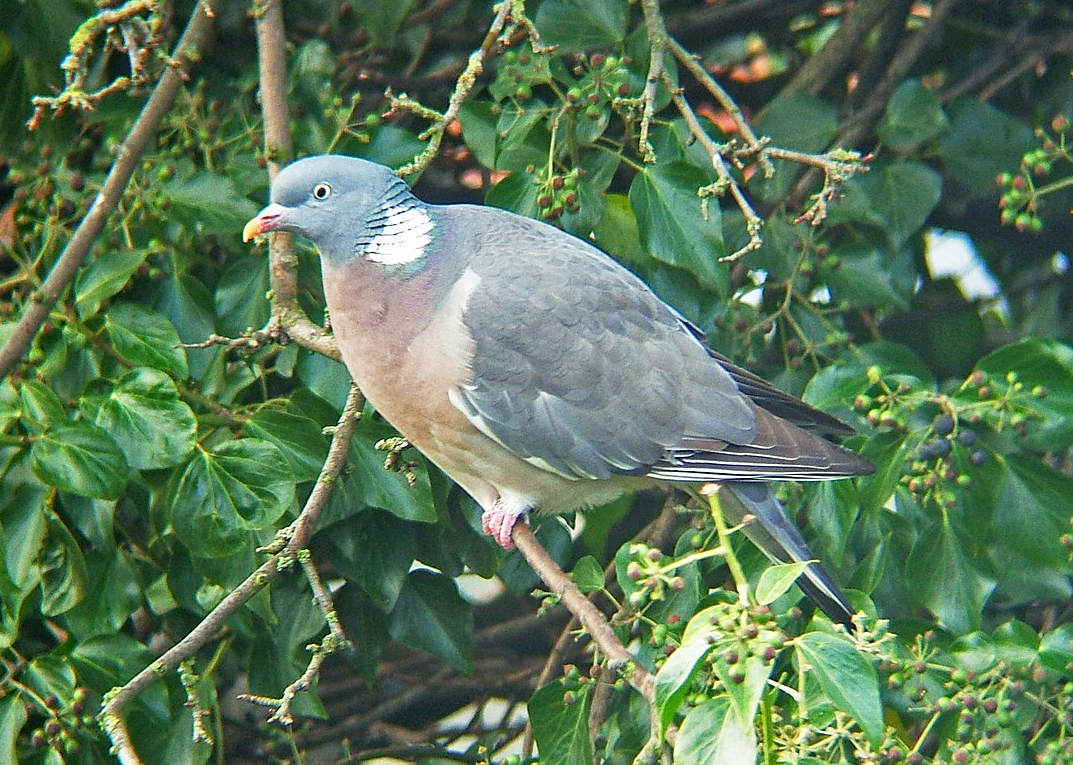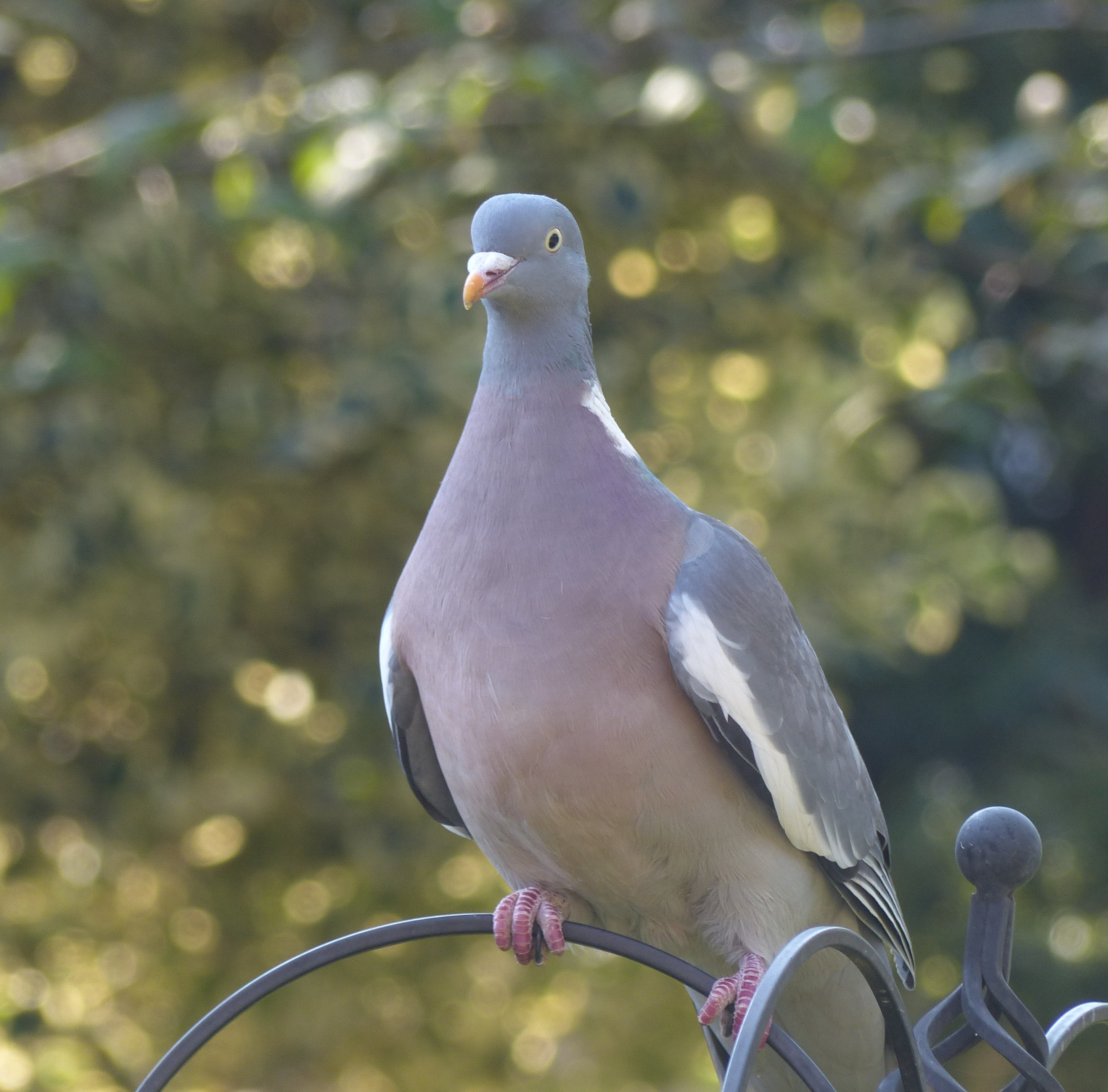Garden Wildlife
Garden Wildlife


Wood Pigeon Columba palumbus
This is one of the biggest and commonest garden birds. BTO’s Garden Birdwatch project has it as the second most commonly reported garden bird in 2019 and 2020, just beaten by blue tit. Many people think of woodpigeons as uninteresting birds and get annoyed when they scoff the food put out for other species. But they are attractive when you look closely, with subtle colours in their plumage and vey expressive ‘faces’. They lead a very public social life in our gardens, crashing about in the bushes and trees and courting vigorously and noisily from midwinter onwards.
What do they look like?
Woodpigeons are large birds with body length 41 cm and weighing nearly half a kilo. Their overall appearance is grey, but with different tones of grey/purple on different parts of the body. There is a white leading edge on the closed wing, and a white patch on the side of the neck in adults but lacking in juveniles. They have a prominent white swelling or ‘cere’ at the base of the bill, and their black eyes have a golden ring around them. The bill is strong, rather hooked and orange in colour. The chest and upper breast are suffused with a plum-purple tinge. The sexes are alike. See our pigeons page to compare with other species.
What do they sound like?
The courtship call of woodpigeons will be familiar to most people – a repetitive Cu-coo-cooo, cu-cu with variations. Some people find it monotonous, but for others it is part of the sound of spring and summer. They also clap their wings when agitated with each other and during their arched gliding territorial flight.
Courtship call Wing clap
What do they eat?
Woodpigeons are plant eaters. They will cram their crops with seeds, fruit, scraps, commercial bird foods and the leaves of garden vegetables. It is entertaining to watch them stumbling about in thick ivy in early winter while harvesting ivy berries. If you grow cabbages and other brassicas you will already be used to taking precautions against hungry pigeons!
What do they do?
Wood pigeons seem to spend a lot of time sitting round doing nothing. They can quickly cram their crops very full with 100 or more grams of food, so that you can see the bulge at the base of their neck. This means they can then spend a lot of time resting while the gathered food is passed on into their stomach and digested.
However at times they get very agitated. There is a continuous clatter of wings and branches in spring and summer as they express rivalry and courtship. A blow from a woodpigeon wing can be serious - they have been known to kill a sparrowhawk, for instance.
Their display flight is distinctive – they fly fast and then glide to a peak and down again over their chosen territory.
In winter they gather in huge flocks scavenging fields for spilt grain and other crops. Thousands of woodpigeons migrate south across the UK each year in autumn.
How are they doing?
The population was about 5.3 million pairs in 2016. They frequent broadleaf woodland, scrub, pasture andarable fields as well as town and country gardens. The BTO Breeding Birds Survey 2019 shows that the woodpigeon population appears to have increased by more than 30% over the last 25 years. You may have noticed that yourself!
Finding out more:
BTO profile on woodpigeon
RSPB profile on woodpigeon
Page written by Roy Smith, compiled by Steve Head


Susanne Kuijpers, XC631222. Accessible at www.xeno-canto.org/631222.

Juvenile bird on feeder
Robert Ekman, XC633317. Accessible at www.xeno-canto.org/633317.
Wood Pigeon Columba palumbus
This is one of the biggest and commonest garden birds. BTO’s Garden Birdwatch project has it as the second most commonly reported garden bird in 2019 and 2020, just beaten by blue tit. Many people think of woodpigeons as uninteresting birds and get annoyed when they scoff the food put out for other species. But they are attractive when you look closely, with subtle colours in their plumage and vey expressive ‘faces’. They lead a very public social life in our gardens, crashing about in the bushes and trees and courting vigorously and noisily from midwinter onwards.




What do they look like?
Woodpigeons are large birds with body length 41 cm and weighing nearly half a kilo. Their overall appearance is grey, but with different tones of grey/purple on different parts of the body. There is a white leading edge on the closed wing, and a white patch on the side of the neck in adults but lacking in juveniles. They have a prominent white swelling or ‘cere’ at the base of the bill, and their black eyes have a golden ring around them. The bill is strong, rather hooked and orange in colour. The chest and upper breast are suffused with a plum-purple tinge. The sexes are alike. See our pigeons page to compare with other species.
What do they sound like?
The courtship call of woodpigeons will be familiar to most people – a repetitive Cu-coo-cooo, cu-cu with variations. Some people find it monotonous, but for others it is part of the sound of spring and summer. They also clap their wings when agitated with each other and during their arched gliding territorial flight.
Courtship call Wing clap
What do they eat?
Woodpigeons are plant eaters. They will cram their crops with seeds, fruit, scraps, commercial bird foods and the leaves of garden vegetables. It is entertaining to watch them stumbling about in thick ivy in early winter while harvesting ivy berries.If you grow cabbages and other brassicas you will already be used to taking precautions against hungry pigeons!
What do they do?
Wood pigeons seem to spend a lot of time sitting round doing nothing. They can quickly cram their crops very full with 100 or more grams of food, so that you can see the bulge at the base of their neck. This means they can then spend a lot of time resting while the gathered food is passed on into their stomach and digested.
However at times they get very agitated. There is a continuous clatter of wings and branches in spring and summer as they express rivalry and courtship. A blow from a woodpigeon wing can be serious - they have been known to kill a sparrowhawk, for instance.
Their display flight is distinctive – they fly fast and then glide to a peak and down again over their chosen territory.
In winter they gather in huge flocks scavenging fields for spilt grain and other crops. Thousands of woodpigeons migrate south across the UK each year in autumn.
How are they doing?
The population was about 5.3 million pairs in 2016. They frequent broadleaf woodland, scrub, pasture andarable fields as well as town and country gardens. The BTO Breeding Birds Survey 2019 shows that the woodpigeon population appears to have increased by more than 30% over the last 25 years. You may have noticed that yourself!
Finding out more:
Page written by Roy Smith, compiled by Steve Head
Juvenile bird on feeder
























